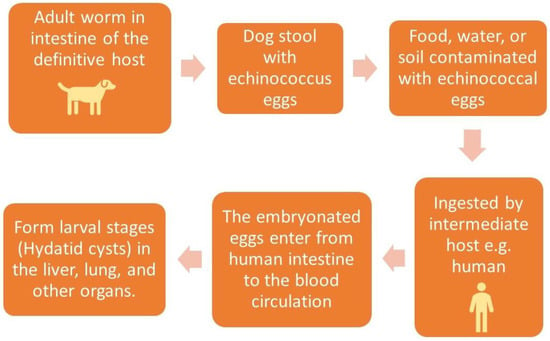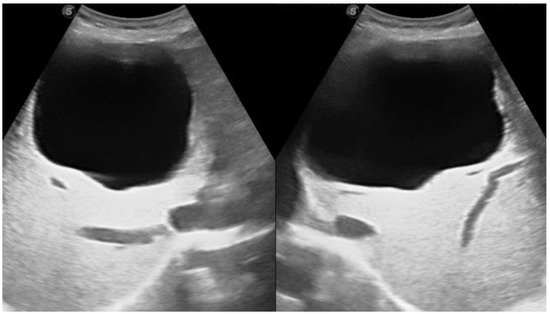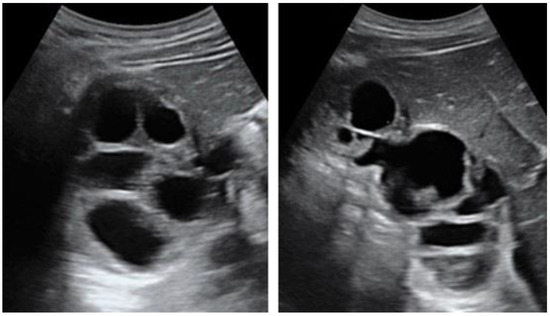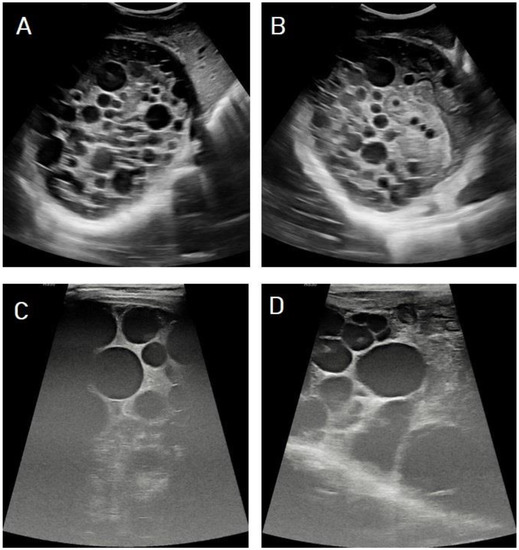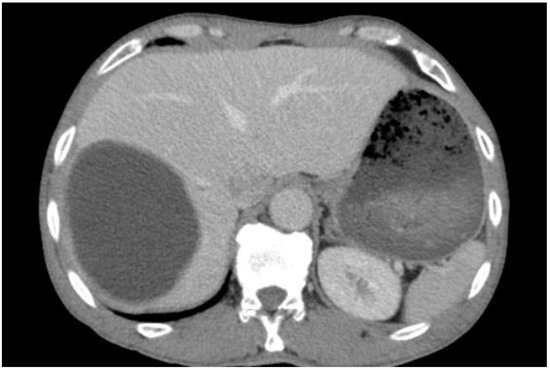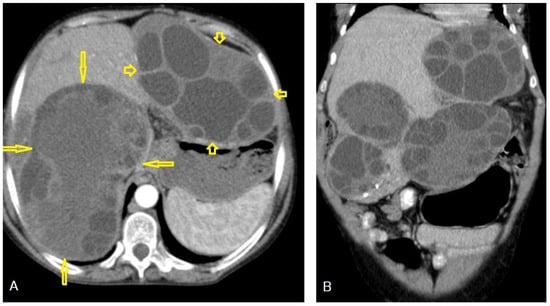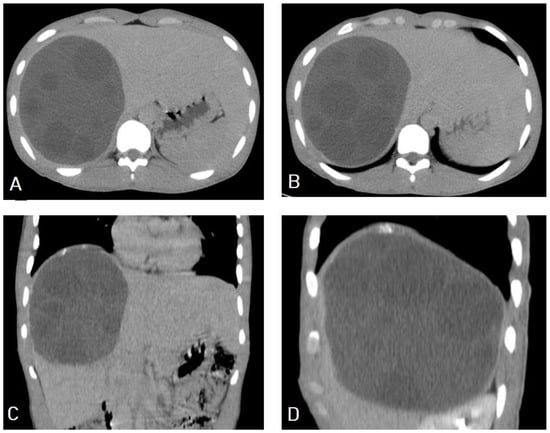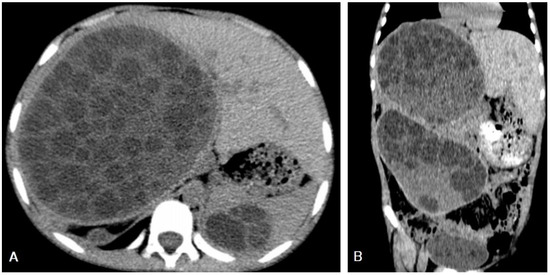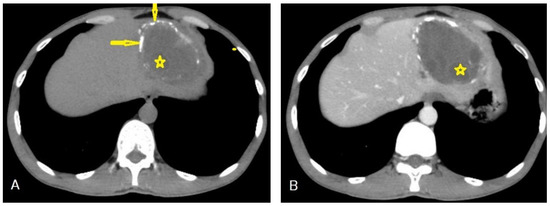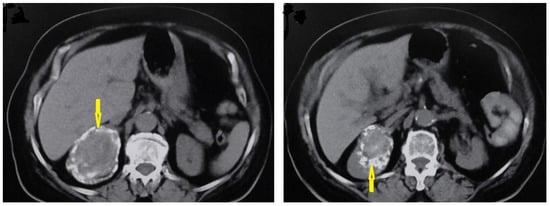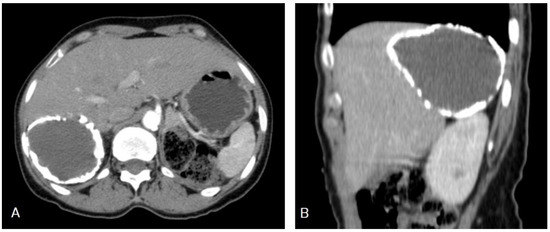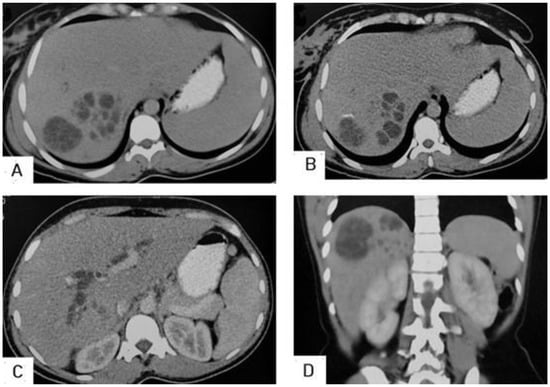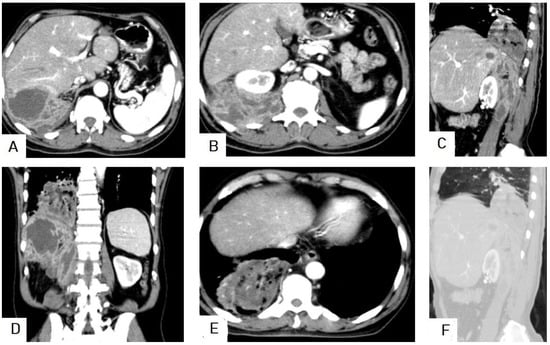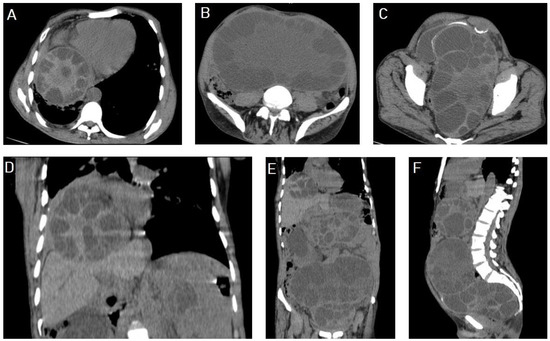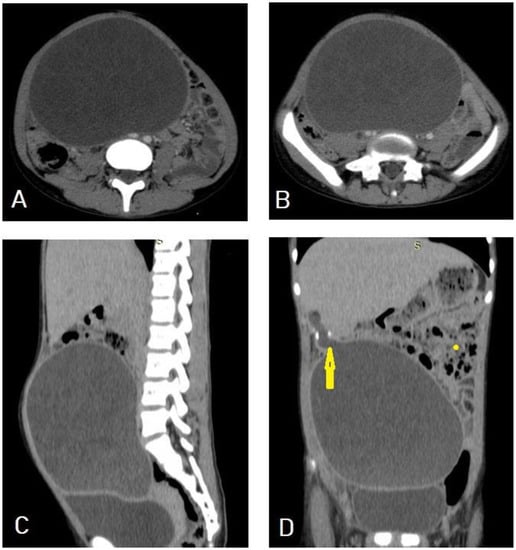Hydatid disease is highly endemic in many livestock-rising areas worldwide, and it is still neglected in scientific research.
2. Diagnosis of Hydatid Cyst
Hydatid disease is diagnosed using medical imaging modalities, including abdominal ultrasound imaging, an X-ray of the chest, and computed tomography (CT) of the abdomen, chest, and brain. Serological antibody-detecting essays using diverse native antigens are only used to confirm the diagnosis because of the great difference in their sensitivities and specificities. An enzyme-linked immunosorbent assay (ELISA) using the synthetic peptide p176 has demonstrated a good performance in diagnosing hydatid disease, with up to 80% and 93% sensitivity and specificity, respectively
[7]. Ultrasound imaging is the first choice due to its availability, lack of radiation, high resolution for diagnosis, differential diagnosis, staging, establishment of a role in interventional management, follow-up, and screening to assess the prevalence of abdominal hydatid cysts. Unenhanced CT is indicated where or when an ultrasound is unsatisfactory, such as in chest or brain hydatid cysts, when detecting calcification, and in obese patients
[8].
Figure 3.
Figure 3. Contrast-enhanced computed tomography of a 15-year-old female presenting with abdominal pain showing a well-circumscribed, unilocular, non-enhanced cystic lesion in the right lobe of the liver with typical “double-wall sign” of hydatid cyst (arrows).
3. Structure of the Hydatid Cyst
Hydatid cysts have the following three layers: (1) The outer layer (pericyst) consists of modified host cells, including fibroblasts, giant cells, and eosinophils, forming a fibrous and protective zone. (2) The middle laminated acellular membrane, which allows passage of the nutrient. (3) The thin inner germinal layer. The middle laminated layer and the inner germinal layer form the true wall of the hydatid cyst, called the endocyst. The thickness of these layers tends to be the thickest in the liver compared to other organs. The acellular laminated layer is occasionally called an ectocyst
[9]. The pericyst is also known as the ectocyst or adventitial layer
[10]. The infectious embryonic tapeworm “scolices” develop from an outpouching of the germinal layer
[9].
4. Classification of Hydatid Cysts
I: The WHO Informal Working Group on Echinococcosis (WHO-IWGE) classification of hydatid cysts assigned six cyst stages into three clinical groups as follows: (1) The “active” group of developing cysts, which may be unilocular (CE1), or multivesicular with daughter vesicles (CE2), which are usually fertile cysts containing viable protoscoleces. (2) The “transitional” group, which may be cysts with a detachment of the endocyst membrane (CE3a), or predominantly solid cysts with daughter vesicles inside it (CE3b). (3) The “inactive” group includes solid contents (CE4), or solid contents with calcification (CE5), which are almost always nonviable. The WHO classification provides a rational basis for choosing the appropriate treatment scheme and follow-up
[8][11][8,11].
Figure 4,
Figure 5 and
Figure 6.
Figure 4. Ultrasound images of a 35-year-old female showing a well-circumscribed, unilocular, anechoic cystic lesion measuring about 10 cm with no internal septation or solid component centered in segment IV of the right hepatic lobe, exerting slight compression on the gallbladder with no remarkable biliary dilatation or frank calcifications. Picture is in keeping with hydatid cyst stage CE1 (WHO classification).
Figure 5. Ultrasound image of a 17-year-old female presenting with upper abdominal pain shows about an 11 × 6 cm well-demarcated, mild lobulated margin with multiple internal septations of higher attenuation seen in segment VI of the right lower hepatic lobe, descended in front, lateral to the right kidney, and exerting mild kidney indentation. Picture is in keeping with the hydatid cyst CE2 (WHO classification).
Figure 6. Ultrasound images of the liver of a 10-year-old male presenting with abdominal pain showing about 15 × 12 cm well-circumscribed, cystic lesion thin echogenic wall replacing the V, VI, and VII segments of right hepatic lobe containing multiple daughter cysts and echogenic matrices (A,B), which are typical images of hydatid cysts in stage CE3b (WHO classification). The daughter cysts appeared more obviously on the high-resolution images of the high-frequency linear transducer (C,D).
II: Based on the medical imaging morphology, hydatid cysts are classified into four types, as follows:
[9][12][13][9,12,13].
Type I: Simple cyst with no architecture: This type constitutes the initial and active phase of hydatid disease in which the three layers are intact
[9]. During the initial stage of development of the hydatid cyst, it appears as a well-circumscribed, unilocular cystic lesion with no internal architecture, with or without internal septations or hydatid sand, with frequent enhancement of the cyst wall and septa on post-contrast CT
[12]. On magnetic resonance imaging (MRI), hydatid cysts appear as a low signal intensity on T1-weighted images (T1WIs), and a high signal intensity on T2-weighted images (T2WIs) with a low signal intensity rim “rim sign”. The DWI sequence can differentiate Type I hydatid cysts from simple liver cysts
[13].
Figure 7.
Figure 7. Selected CT images of a 35-year-old female showing a well-circumscribed, round, unilocular hypodense cystic lesion centered in segment IV of the right hepatic lobe, measuring about 10 × 7.7 × 6.3 cm with no internal septation or solid component, no frank calcifications, or enhanced internal component after contrast administration, which is a typical image of hydatid cyst Type I.
Type II: Cyst with daughter cysts and matrix: This type represents the active phase in the parasite life cycle and in the dissemination of hydatid disease
[9]. Cysts with multiple septa representing the walls of the daughter cysts inside the mother cyst are usually arranged in the periphery. According to the maturity and arrangement of the daughter cyst, Type II can appear as follows: (1) Type IIA contains multiple daughter cysts arranged at the periphery of the mother cyst with a high density central matrix forming a “wheel spoke appearance”, (2) Type IIB contains multiple irregular daughter cysts occupying the cyst forming “rosette appearance”, and (3) Type IIC contains a hyperdense matrix and occasionally calcification or daughter cysts
[12]. On an MRI, daughter cysts appear on a low signal intensity or isointense relative to the matrix on both T1WIs and T2WIs
[13].
Figure 8,
Figure 9,
Figure 10 and
Figure 11.
Figure 8. Selected axial (A) and coronal (B) CT images of a 60-year-old female showing multiple well-defined cystic lesions occupying the liver: about five lesions in the right lobe, where the largest one measured 17 × 9.2 × 15.3 cm (long arrows), occupying the right posterior lobe, and two cysts occupying the left lobe, where the largest one measured 11.4 × 10.3 × 8.7 cm (short arrows). Most of the lesions contain multiple vesicular cysts inside them (daughter cysts). The lesions exert a compression effect on the portal vein, stomach, and ascending colon, intending to reach the right kidney upper pole. This is a typical picture of an active-stage hydatid cyst Type IIA.
Figure 9. Selected axial (A,B) and coronal (C,D) CT images of a 16-year-old male presenting with abdominal pain and distension showing a well-defined cystic lesion in the right lobe of the liver, containing multiple vesicular cysts (daughter cysts) and hyperdense matrix, and forming the “spoke-wheel” appearance of a hydatid cyst.
Figure 10. Selected axial (A) and sagittal (B) CT image of a 10-year-old male presenting with abdominal pain shows an enlarged liver with about a 15 × 12 cm thin-wall cystic lesion seen replacing the V, VI, and VII segments of right hepatic lobe containing multiple daughter cysts, which is typical picture of a hydatid cyst with normal biliary tree and portal vein. Another similar thin-wall cystic lesion measuring about 5.5 × 3.7 cm contains multiple daughter cysts, which is a typical picture of hydatid cysts of the spleen. Additionally, showing multiple similar cystic lesions measuring about 11 × 16 cm in the right upper abdominal cavity causing mass effect in the displacement of the right kidney, and another three smaller cystic lesions in the right subphrenic space measuring about 3.8 × 5.2 cm, 4 × 2 cm, and 4 × 1.5 cm. Moreover, showing another similar cystic lesion at the recto-vesical pouch measuring about 6 × 4 cm. The above findings represent a typical case of liver, spleen, and peritoneal hydatidosis and Type IIB.
Figure 11. Selected axial non-enhanced (A), and contrast-enhanced (B) CT images of the abdomen of an adult male patient showing a well-circumscribed hypodense cystic lesion with multiple daughter cysts inside it (stars), with stippled calcification of the wall (arrow), and with no enhancement after contrast administration. Picture of hydatid cyst Type IIC.
Type III: Calcified cysts: This phase constitutes the inactive dead phase of hydatid disease, which cannot spread, has no mass effect or complications, and does not require surgery
[9]. It appears as a calcified lesion with posterior acoustic shadowing on ultrasound imaging, a round hyperdense lesion on CT, and a low signal intensity area on an MRI
[13]. CT is the gold standard imaging modality used to diagnose calcified hydatid cysts
[12].
Figure 12 and
Figure 13.
Figure 12. Selected axial images of abdominal CT of a 60-year-old female showing a well-circumscribed unilocular cystic lesion in the right kidney with calcified margins (arrows), no mass effect, and no daughter cysts inside it, which is typical of hydatid cyst Type III.
Figure 13. Selected axial (A) and sagittal (B) CT images of a 50-year-old female presenting with right upper quadrant pain, showing a well-circumscribed unilocular cystic lesion in the right lobe of the liver with calcified margins and no daughter cysts inside it, which is typical of inactive hydatid cyst Type III.
Type IV: Complicated hydatid cyst: This is a hydatid cyst with a rupture or superinfection, which may be seen in both Types I and II
[13]. CTs and MRIs play a major role in diagnosing complicated hydatid cysts
[12][13][12,13]. The rupture of hydatid cysts occurs in 50% of cases, mainly due to age degeneration of the parasitic membrane or a defense mechanism
[13]. Complications of hydatid cysts include the following: (1) Mass effect: This is when a cyst reaches a large size, which can cause biliary duct dilatation either by compression of the nearby duct or by perforation into the biliary duct. (2) Rupture of hydatid cyst: A rupture may be internal, communicating with the passage of the cystic contents into the biliary ducts, or direct, when cystic content spillage into the peritoneal cavity causes disseminated disease. (3) Hydatid disease infection is generally seen in ruptured hydatid cysts, which permits bacteria to pass easily into the cyst. Air within the cyst cavity is a clue, as it is thick and enhances walls after contrast administration on CTs and MRIs. (4) Exophytic growth occurs via the bare area of the liver with transdiaphragmatic migration to the lung or mediastinum, or via the gastrohepatic ligament into the peritoneal cavity. (5) Peritoneal seeding is almost always secondary to hepatic hydatid disease. It occurs due to previous hepatic hydatid surgery or after a spontaneous or traumatic rupture. CTs and MRIs are valuable imaging modalities for diagnosing peritoneal hydatid cysts
[9].
Figure 14,
Figure 15,
Figure 16,
Figure 17 and
Figure 18.
Figure 14. Selected CT images of a 26-year-old male showing multiple well-defined grouped cysts in the right lobe of the liver, the largest about 4 cm, seen on axial (A) section, with partial peripheral calcification seen on axial (B) section. There are multiple irregular, ill-defined small cysts around the confluence of the main hepatic bile ducts seen on axial (C) section with moderate dilatation of the common bile duct and mild dilatation of the intrahepatic biliary tree seen on coronal (D) section. Picture is in keeping with biliary tree seeding from the liver hydatid cyst.
Figure 15. Selected CT images of a 40-year-old male presenting with cough and dyspnea showing a ruptured liver hydatid cyst complicated with disastrous dissemination into the peritoneal cavity seen on the axial section (A), and bilateral chest seeding seen on axial (B), sagittal (C), and coronal (D) sections. Picture is in keeping with peritoneal and bilateral chest seeding from the liver hydatid cyst.
Figure 16. Selected CT images of an 80-year-old man presenting with chest pain, showing about 6.8 × 4 cm multiloculated and peripherally enhanced collection and seeming to arise from the subcapsular segment-VII of the right lobe of liver with disrupted capsule and exophytic tracking component to subphrenic region into the posterior perinephric and pararenal spaces seen on axial (A,B) sections, and extending across the proximal psoas muscle for about 7.5 cm caudally seen on sagittal (C) and coronal (D) sections. Superiorly, the lesion tracks the right hemidiaphragm into the lung, where there is a well-circumscribed mass-like lesion measured at 8.7 × 6.3 × 5 cm with thickened wall with obvious bronchovascular markings seen extended within the lesion in the adjacent lower lobe area seen on sagittal (C), coronal (D), axial (E), and sagittal lung window (F) sections. The picture suggests ruptured hepatic hydatid cyst tracking to the retroperitoneaum, psoas muscle, and lung, with superimposed psoas abscess formation.
Figure 17. Selected CT images of a 60-year-old male with renal impairment presenting with abdominal pain and distention, showing about 8.6 × 8.2 cm hydatid cyst with multiple daughter cysts in the lower lobe of the right lung, indenting the right hemidiaphragm, and compressing the lower liver seen on axial (A) and coronal (D) sections. Additionally, showing multiple abdominal and pelvic large hydatid cysts with multiple internal daughter cysts compressing bilateral ureters, causing moderate bilateral hydronephrosis, and compressing the urinary bladder anteriorly seen on axial (B,C), coronal (D,E), and sagittal (F) sections. Pictures from Type IIA with typical “spoke-wheel appearance” occurring on images (A–D).
Figure 18. Selected CT images of a 13-year-old patient presenting with abdominal distention and feeling mass showing about a 16 × 15 × 11 cm well-circumscribed, multiloculated cystic lesion in the right side of abdominal and upper pelvic cavities as seen in axial (A,B) sections, exerting mass effect in the form of bilateral mild hydronephrosis, displacing the bowel loops laterally, and compressing the urinary bladder as seen in the sagittal (C) and coronal (D) sections. The cyst had a narrow neck-like (arrow) at the superolateral aspect connected with other cystic lesions in segment-VI of the liver. The above findings are in keeping with a large abdominal hydatid cyst.
References:
- Agudelo Higuita, N.I.; Brunetti, E.; McCloskey, C. Cystic Echinococcosis. Clin. Microbiol. 2016, 54, 518–523. https://doi.org/10.1128/JCM.02420-15.
- Zhang, T.; Li, B.; Liu, Y.; Liu, S. Risk Factors Associated With Echinococcosis in the General Chinese Population: A Meta-Analysis and Systematic Review. Public Health 2022, 10, 821265. https://doi.org/10.3389/fpubh.2022.821265.
- Lodhia, J.; Chugulu, S.; Sadiq, A.; Msuya, D.; Mremi, A. Giant isolated hydatid lung cyst: Two case reports. Med. Case Rep. 2020, 14, 200. https://doi.org/10.1186/s13256-020-02524-4.
- Torgerson, P.R.; Devleesschauwer, B.; Praet, N.; Speybroeck, N.; Willingham, A.L.; Kasuga, F.; Rokni, M.B.; Zhou, X.N.; Fèvre, E.M.; Sripa, B.; et al. World Health Organization Estimates of the Global and Regional Disease Burden of 11 Foodborne Parasitic Diseases, 2010: A Data Synthesis. PLoS Med. 2015, 12, e1001920. https://doi.org/10.1371/journal.pmed.1001920.
- Da Silva, A.M. Human echinococcosis: A neglected disease. Res. Pract. 2010, 2010, 583297. https://doi.org/10.1155/2010/583297.
- Ines, M.; Mariem, B.L.; Marwa, M.; Amina, B.S.; Chiraz, H. Isolated breast hydatid cyst: Imaging features. Case Rep. 2022, 10, e06362. https://doi.org/10.1002/ccr3.6362.
- Santivañez, S.J.; Arias, P.; Portocarrero, M.; Rodriguez, S.; Gonzalez, A.E.; Gilman, R.H.; Gavidia, C.M.; Garcia, H.H. Serological diagnosis of lung cystic hydatid disease using the synthetic p176 peptide. Vaccine Immunol. 2012, 19, 944–947. https://doi.org/10.1128/CVI.05540-11.
- Brunetti, E.; Tamarozzi, F.; Macpherson, C.; Filice, C.; Piontek, M.S.; Kabaalioglu, A.; Dong, Y.; Atkinson, N.; Richter, J.; Schreiber-Dietrich, D.; et al. Ultrasound and Cystic Echinococcosis. Ultrasound Int. Open. 2018, 4, E70–E78. https://doi.org/10.1055/a-0650-3807.
- Polat, P.; Atamanalp, S.S. Hepatic hydatid disease: Radiographics findings. Eurasian J. Med. 2009, 41, 49.
- Golzari, S.E.; Sokouti, M. Pericyst: The outermost layer of hydatid cyst. World J. Gastroenterol. 2014, 20, 1377–1378. https://doi.org/10.3748/wjg.v20.i5.1377.
- WHO Informal Working Group. International classification of ultrasound images in cystic echinococcosis for application in clinical and field epidemiological settings. Acta Trop. 2003, 85, 253–261. https://doi.org/10.1016/s0001-706x(02)00223-1.
- Mehta, P.; Prakash, M.; Khandelwal, N. Radiological manifestations of hydatid disease and its complications. Parasitol. 2016, 6, 103–112. https://doi.org/10.4103/2229-5070.190812.
- Marrone, G.; Crino, F.; Caruso, S.; Mamone, G.; Carollo, V.; Milazzo, M.; Gruttadauria, S.; Luca, A.; Gridelli, B. Multidisciplinary imaging of liver hydatidosis. World J. Gastroenterol. 2012, 18, 1438–1447. https://doi.org/10.3748/wjg.v18.i13.1438.
